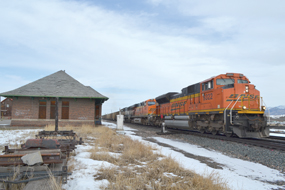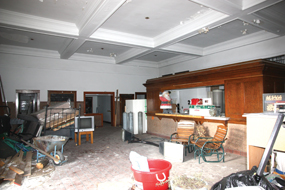Gauging the Future of Bozeman’s NP Passenger Depot
Tuesday Apr. 30th, 2013
Twice a month I respond to an inquiry about the Northern Pacific Passenger Depot, at 820 Front Street in Bozeman. Callers ask for the owner’s contact information, in hopes of redeveloping the building into a restaurant, a bar, a martial arts studio, a community center for returning veterans, a library, business offices and any number of other endeavors. Clearly, community interest in seeing this shuttered building reused is high.
The existing structure is actually two parts. In an effort to sway voters during the state capital bid of 1892, Bozeman worked with the Northern Pacific to construct a passenger depot more impressive than the NP’s standard wood frame building. A brick depot with some Romanesque style details such as rounded window transoms and a centralized turret was constructed. The brick color and red mortar used to join the bricks appeared similar to Montana Hall on the Montana State University campus. Though an upgrade from the standardized passenger depot of the NP, the 1892 building was a far cry from the refined facilities the NP built in Livingston and Missoula a decade later.
By 1923 burgeoning rail passenger traffic in and out of Bozeman necessitated an expansion of the depot. Again, Bozeman worked with the Northern Pacific to design an attractive building to shelter passengers. Though the original architect is unknown at this time (likely a Northern Pacific staff architect), reports that Bozeman architect Fred Willson designed the structure are inaccurate. Willson likely served as the architect on-site monitoring construction for the NP’s main offices in Minneapolis but it’s unclear how much, if any, influence he had on the building’s design.
The 1923-1924 remodel of the NP Passenger Depot added to the south end of the 1892 building. Windows were bricked in, doorways moved and the central turret feature dismantled and streamlined. A large square addition to the south became the primary focal point of the façade and the entire structure was clad in a red, wire-raked brick. The 1892 structure was re-faced with the new brick and totally incorporated into the new building. Deep roof eves and inverted knee brackets reflect the influence of the Prairie Style on the 1923-24 remodel.
The new addition housed passenger waiting areas. The large main passenger waiting room included a terra cotta floor, tile wainscoting, expansive ticket booth and soaring beamed ceiling. Though slightly water damaged, these spaces all remain intact and beg for restoration.
The ladies waiting room, to the south side of the building, was altered at some point, likely in the 1960’s. Green carpet covers the floor, wood paneling now hides original tile wainscoting on the walls and a drop ceiling camouflages the room’s original high ceilings. Though hidden, these elements can all be restored. The ladies toilet area retains its original tile flooring, tile walls and granite stall partitions.
The men’s smoking room, created in 1924 on the west façade of the structure, was also extensively altered at some point in the mid-20th century. The smoking room, a vestibule through which a passenger entered the men’s toilet area, was incorporated into a baggage intake room and replaced with a hallway. The men’s toilet area also still has its granite stall partitions and most of the original finishes.
The remainder of the Passenger Depot was utility space for the Northern Pacific. The 1892 portions of the structure became baggage and freight rooms, as well as offices. One mystery in this area appears on the 1923-24 remodel drawing set: a “Fish scale” is called out as a specific area in the freight room. Was this some kind of storage facility for the fish being bred at the fish hatchery near the M? Or a way in which fly-fishing tourists could take their prize home? If you know the answer- please tell us!
The depot was shuttered when rail passenger service ended in the late 1970’s, as completion of the Interstate Highway system entrenched personal automobiles as the preferred mode of travel. With exception of a brief stint as a set in A River Runs Through It, the building has been used as storage ever since.
So how can we spur preservation of this historically significant building in Bozeman’s Northern Pacific Historic District? How can rehabilitation of this structure spur other redevelopment in Bozeman’s eclectic north east neighborhood?
This spring the Northeast Urban Renewal Board, the Bozeman Historic Preservation Advisory Board, Montana Rail Link and the National Trust for Historic Preservation partnered to complete a structural analysis of the building. The first step in adaptive reuse of the building is understanding the opportunities and hurdles the physical structure presents. The project will evaluate the structural integrity of the building, including mechanical systems, plumbing, electrical wiring, the foundation’s stability and roof deterioration.
The final report will recommend immediate steps to properly mothball the building to prevent further deterioration. The report will then expand to discuss approaches for rehabilitating the building, suggestions for areas in which restoration is a primary focus and areas in which spaces can be changed in order to accommodate a new use. While it won’t answer important issues like ownership and leasing options, the document will address the needs of the physical structure. The entire report will be made available to the public and is intended to spur private investment in the structure in partnership with the property owners Montana Rail Link and Burlington-Northern-Santa Fe Railroad.
The project’s partners are hosting a community meeting about the future of the depot at 6pm on Thursday, May 9 at the Bozeman Public Library (626 East Main Street, Bozeman). Railfans and community members are invited join us for light refreshments and a presentation by the architectural team writing the report. Additionally, community members with personal photos of the depot or an answer to the “fish scale” riddle are asked to contact me at: ckramer@bozeman.net
This article would be incomplete without a thanks to Mark Hufstetler, Chairman of the Bozeman Preservation Board; Dale Martin, Northern Pacific Railway historian; consulting preservation architect Lesley Gilmore, CTA architects and Engineers, and Erik Nelson and Tom Noble, past and present Chairmen of the Northeast Urban Renewal Board. Special thanks to Joe Gentri, of Montana Rail Link for his superb assistance in bringing this project to fruition.
Courtney Kramer is a proud graduate of MSU’s History Department and serves as the City of Bozeman’s Historic Preservation Officer. She may be contacted at the City Planning Office, 406-582-2260 or via email at ckramer@bozeman.net. More information about Bozeman’s historic districts is available at www.preservebozeman.org
| Tweet |